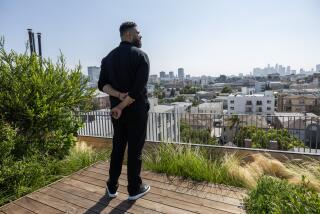The Denny Beating Trail: The Verdicts : Two Worlds in One L.A. : Outside the Courts but Inside the City: Where Hope, Renewal Begin
- Share via
By chance, the groundbreaking for the First African Methodist Episcopal Church’s new low-income housing project was held about an hour before the announcement of the verdicts in the Reginald Denny beating trial.
The First AME event had been scheduled long before anyone suspected that the two events would coincide. But, as the Rev. Cecil L. Murray, the church’s pastor, might say, the timing was dictated by Providence. For the symbolism was perfect.
FAME Gardens--81 units and a child-care center for about 75 neighborhood children--means hope, healing and renewal in South-Central Los Angeles. The warm fall sunshine emphasized the point.
On the other hand, the verdicts, announced in the gloom and despair of the Criminal Courts Building, opened wounds. The verdicts angered many who saw the beating on television and wanted the defendants guilty of all counts. And even though the jury rejected some of the most serious charges against Damian Williams and Henry Watson, no doubt the verdicts still infuriated the few who portray them as victims of a racist judicial system.
After returning from the groundbreaking, I watched the verdicts on television. I thought that if you want to redress society’s wrongs, don’t look to the criminal courts for satisfaction.
*
More often than not, society’s ills are corrected by projects such as FAME Gardens, efforts usually too modest to be noticed by the mass media, even the groundbreaking of a $15-million housing development.
This day, however, was different. FAME Gardens, located on a hilly portion of 27th Street near Arlington, drew at least 10 cameras and several print reporters.
They were there not to cover the groundbreaking as much as to seek reaction to the verdicts. First AME is a center of African-American community activism. The Rev. Murray and others in the church are among the city’s leading peacemakers during times of tension. Everyone wanted to hear what he had to say.
Murray stood in front of the 1923 Italian Renaissance Revival mansion built by George and Clara Veatch that will be converted into the child-care center. It sits on a large lot with a view of the city.
He said it wasn’t enough to be concerned only with the trial. “We felt we should, by all means, go ahead with the groundbreaking,” Murray said. “We cannot afford the luxury of moving on one front,” he said. “Black America cannot, anyway.”
In the case of this project, he said, “we have to take poor folks and make them feel so good about themselves that they will contribute to the community.”
First AME began building housing for low-income residents in 1986, just as construction of inexpensive apartments slowed in L.A. and many older buildings were being torn down. Homelessness moved out from Skid Row, where it once had been centered.
About that time, homeless encampments began appearing in housing-short South-Central L.A., a phenomenon that is now widespread.
Part of the new development was financed by $7.1 million in the Los Angeles Community Redevelopment Agency funds brought in by the successful redevelopment of Bunker Hill. The CRA has spent $333 million in Bunker Hill money since 1977 to help build 14,000 housing units.
The rest of it came from bank loans and from the sale of $8 million in tax credits, which provide investors with a federal income tax break.
When it’s done, two-bedroom apartments will rent for between $406 and $582 a month and three-bedroom units for $443 to $667.
*
Bankers, lawyers, church officials, CRA staff members and financial consultants worked many hours to put this deal together. Adding a child-care center complicated it. Lenders feared lawsuits from parents of injured children.
There were no heroes or villains in these late-night meetings, just a bunch of earnest pluggers. Nor were there demonstrators outside.
But this is how the city is slowly recovering from the riots--by inches.
Rebuild L.A. persuades some businesses to remain in L.A. The Century Freeway is opened, as is the new Central Library. New housing projects for the poor go up around town.
Unfortunately, many of these accomplishments lack the excitement and larger-than-life quality demanded by journalists and their readers and viewers. We like drama, tension, heroes and villains, strife--all of it viewed through a curtain of unrelenting gloom.
Trials are perfect for this. The Denny beating trial was made larger than life, as if the future of L.A. was at stake. So were the trials of the cops who beat Rodney King.
This is too much to ask of proceedings held in the dreary, crowded confusion of the Criminal Courts Building. The role of criminal trials is not to determine the future of cities. All they do is perform the relatively narrow function of deciding whether someone is guilty or not guilty of a crime.
The work of saving the city is done elsewhere.
More to Read
Sign up for Essential California
The most important California stories and recommendations in your inbox every morning.
You may occasionally receive promotional content from the Los Angeles Times.










